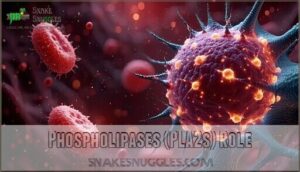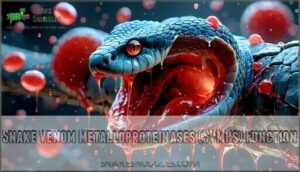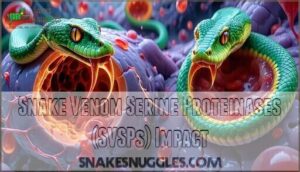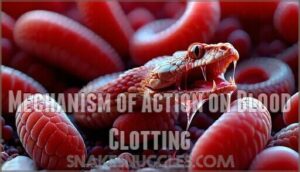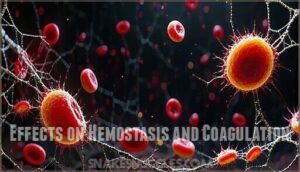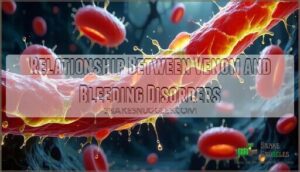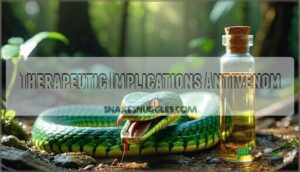This site is supported by our readers. We may earn a commission, at no cost to you, if you purchase through links.
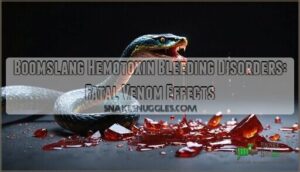
The venom contains powerful enzymes that destroy your blood’s ability to clot properly.
You’ll experience internal bleeding, nausea, and headaches that can take up to 48 hours to appear.
This delayed onset makes boomslang bites particularly dangerous – you might feel fine initially while the venom silently attacks your clotting system.
The hemotoxins target specific proteins in your blood, causing what doctors call VICC (venom-induced consumption coagulopathy).
Without proper antivenom treatment, these bleeding disorders can prove fatal as your body loses its natural ability to stop hemorrhaging.
Table Of Contents
- Key Takeaways
- Boomslang Venom Effects
- Hemotoxin Induced Bleeding
- Diagnostic Challenges VICC
- Therapeutic Implications Antivenom
- Managing Hemotoxin Bleeding
- Frequently Asked Questions (FAQs)
- Can a boomslang make you bleed?
- What is the bleeding disorder from a snake bite?
- Why is there no antivenom for boomslang?
- What does boomslang venom do to the human body?
- Does boomslang venom make you bleed?
- How does venom from boomslang impact hemostasis?
- What does hemotoxic venom do to blood?
- How does snake venom affect blood clotting?
- Whats the survival rate for boomslang bites?
- How common are bleeding disorders from boomslang bites?
- Conclusion
Key Takeaways
- You’ll face a deceptive delay – boomslang venom symptoms can take 12-48 hours to appear, creating a false sense of safety while the toxins silently destroy your blood’s clotting ability
- Your blood will lose its ability to clot properly due to venom-induced consumptive coagulopathy (VICC), causing uncontrolled internal bleeding from multiple organs including gums, nose, and brain
- You’ll need immediate antivenom treatment even if you feel fine initially – monovalent boomslang antivenom is your only defense against the hemotoxic venom’s systematic attack on your coagulation system
- You can’t rely on standard first aid for this bite – the venom’s complex enzyme cocktail (metalloproteinases, phospholipases, and serine proteinases) requires specialized medical intervention to prevent fatal hemorrhaging
Boomslang Venom Effects
When you’re bitten by a boomslang, you’re facing one of nature’s most dangerous hemotoxic venoms that systematically destroys your blood’s ability to clot.
When you’re bitten by a boomslang, time becomes your enemy as hemotoxic venom silently destroys your blood’s clotting ability.
The venom’s complex cocktail of enzymes works like a biological time bomb, quietly dismantling your coagulation system while you mightn’t even realize the severity of your situation, which can lead to a hemotoxic effect.
Hemotoxic Venom Composition
When you’re exposed to boomslang venom, you’re facing a complex cocktail of deadly venom proteins.
This hemotoxic mixture contains three major enzyme groups that create devastating coagulation cascade disruption and fibrinogen depletion.
Here’s what makes boomslang venom toxicity so lethal:
- Snake venom metalloproteinases (SVMPs) – comprising 75-78% of total venom proteins, these enzymes trigger massive hemorrhaging
- Phospholipase A₂ (PLA₂) enzymes – destroy cell membranes while amplifying hemotoxic effects throughout your circulatory system
- Snake venom serine proteinases (SVSPs) – disrupt blood clotting mechanisms, creating incoagulable blood within hours
This toxin diversity creates extraordinary venom potency, with geographic variation affecting enzyme activity levels across different populations.
The tragic case of Karl Patterson Schmidt’s death underscores this danger.
Phospholipases (PLA2s) Role
Through complex enzymatic pathways, PLA2s in boomslang venom trigger devastating bleeding disorders by disrupting your blood’s clotting mechanisms.
These enzymes hydrolyze membrane phospholipids, releasing inflammatory compounds that compromise coagulation cascade function, leading to uncontrolled hemorrhaging.
Antivenom remains the primary treatment, although it has limitations.
| PLA2s Mechanism | Toxicity Effects | Clinical Impact |
|---|---|---|
| Hydrolyzes phospholipids at sn-2 position | Membrane disruption and cell death | Delayed bleeding symptoms |
| Ca²⁺-dependent catalytic activity | Inflammatory mediator release | Consumptive coagulopathy |
| Interfacial activation enhancement | Platelet aggregation modulation | Fibrinogen depletion |
| Asp/His/water triad coordination | Arachidonic acid pathway activation | Hemolysis and myoglobinuria |
| Lysophospholipid production | Anticoagulant effects on factors X/II | Multi-organ bleeding risk |
svPLA2 enzymes exhibit significant catalytic activity, which is a crucial aspect of their toxicity effects and contributes to consumptive coagulopathy and multi-organ bleeding risk.
Snake Venom Metalloproteinases (SVMPs) Function
Snake Venom Metalloproteinases function as the primary architects of boomslang venom’s deadly effects.
These zinc-dependent enzymes target basement membrane proteins, weakening blood vessel walls and triggering venom-induced consumptive coagulopathy.
SVMP structure includes metalloproteinase domains that hydrolyze collagen IV, causing microvascular hemorrhage.
Understanding SVMP mechanism helps explain why snakebite coagulation disorders develop so rapidly in hemotoxin envenomation.
Snake Venom Serine Proteinases (SVSPs) Impact
Within boomslang venom, you’ll find SVSPs acting like molecular scissors that slice through your blood’s clotting proteins.
These enzymes demonstrate remarkable SVSP specificity, targeting fibrinogen and other coagulation factors with precision.
Their SVSP structure allows direct activation of clotting pathways, creating VICC and hemorrhagic syndrome.
Understanding SVSP function reveals why snakebite coagulation becomes dangerously disrupted, making blood clotting impossible.
Hemotoxin Induced Bleeding
When you’re bitten by a boomslang, the snake’s hemotoxic venom targets your blood’s ability to clot properly, setting off a deadly chain reaction throughout your circulatory system.
You’ll experience a condition called venom-induced consumptive coagulopathy, where your clotting factors become depleted and your blood can’t form the clots needed to stop bleeding.
Mechanism of Action on Blood Clotting
When boomslang hemotoxic venom enters your bloodstream, it triggers catastrophic coagulation cascade disruption through clotting factor activation.
The venom’s proteins cause fibrinogen degradation while simultaneously inducing platelet aggregation inhibition.
This creates venom-induced consumptive coagulopathy (VICC), where your blood clotting mechanisms become dangerously compromised.
The result? Hemorrhage inducement throughout your body as coagulation disorders take hold, making bleeding nearly impossible to stop, leading to a state of severe hemorrhage.
Effects on Hemostasis and Coagulation
When hemotoxic venom enters your bloodstream, it launches a systematic attack on your body’s hemostatic mechanisms.
This venominduced consumptive coagulopathy overwhelms normal bleeding control through multiple pathways.
Here’s how boomslang venom disrupts your coagulation system:
- Clotting Factor Activation – Your clotting factors get rapidly depleted as the venom forces excessive activation
- Coagulation Cascade Disruption – Normal clotting sequences become chaotic, preventing proper clot formation
- Platelet Function Inhibition – Your platelets can’t stick together effectively to plug bleeding sites
- Fibrinolysis Impairment – Your body loses ability to properly dissolve clots when needed
- Endothelial Cell Damage – Blood vessel walls weaken, making internal bleeding more likely
The anticoagulant effects create coagulation disorders that manifest as uncontrolled bleeding throughout your body.
Relationship Between Venom and Bleeding Disorders
You’ll find that venom coagulopathy creates a dangerous cascade in your bloodstream.
When hemotoxic proteins disrupt clotting mechanisms, toxin mechanisms trigger venom-induced consumptive coagulopathy.
This hemorrhagic syndrome depletes essential coagulation factors, causing severe internal bleeding.
Clotting disruption varies with venom variation, creating unpredictable hematological abnormalities and hemorrhage severity patterns.
| Bleeding Pattern | Severity Level |
|---|---|
| Gum bleeding | Mild to moderate |
| Nosebleeds | Moderate |
| Internal organ bleeding | Severe to fatal |
| Brain hemorrhage | Critical/fatal |
Diagnostic Challenges VICC
Identifying venom-induced consumptive coagulopathy (VICC) after a boomslang bite presents significant clinical challenges that can delay critical treatment.
You’ll face a diagnostic puzzle because symptoms often don’t appear for 12 to 48 hours after envenomation, creating a deceptive window where patients feel fine despite circulating hemotoxins already disrupting their blood clotting systems, which is a result of the hemotoxins.
Early Signs and Symptoms of VICC
You’ll recognize early VICC symptoms when boomslang venom disrupts your coagulation factors.
Initial bleeding manifests as subtle hemorrhagic syndrome before progressing to uncontrolled bleeding.
Watch for these warning signs that indicate internal bleeding complications:
- Gum bleeding that won’t stop after brushing your teeth
- Nosebleeds occurring without trauma or injury
- Unexplained bruising and swelling appearing on your skin
Lethargy and hiding can also indicate potential illness as key signs of internal bleeding complications.
Delayed Presentation of VICC Symptoms
You won’t realize you’re bleeding internally for hours or even days after a boomslang bite.
The silent killer strikes without warning—bleeding begins hours after you think you’re safe.
This delayed onset variability makes Dispholidus typus snake venom particularly dangerous—bleeding manifestations don’t appear immediately, creating diagnostic delays that worsen patient outcomes.
The sneaky nature of this hemotoxic poison means treatment timing becomes critical once hematological disorders finally surface.
Early detection using VICC diagnostic tests can substantially improve outcomes.
Diagnostic Approaches for VICC
When symptoms appear, you’ll need specific tests to confirm VICC diagnosis.
The 20-minute whole blood clotting test (WBCT20) works well in resource-limited settings, showing 87% sensitivity for detecting boomslang venom effects.
Laboratory tests include prothrombin time, D-dimer levels above 2.5 mg/L, and fibrinogen measurements.
These coagulation assays help distinguish snakebite complications from other hematological disorders, guiding proper differential diagnosis and treatment decisions.
The test kits themselves are available at WBCT20 test kit.
Therapeutic Implications Antivenom
When you’re facing a boomslang bite, antivenom represents your most critical lifeline against the snake’s deadly hemotoxic venom.
You’ll need prompt treatment with monovalent boomslang antivenom, as it’s specifically designed to neutralize the venom’s coagulopathic effects and prevent fatal bleeding complications, which is a critical aspect of treatment.
Antivenom Treatment Efficacy
You’ll find monovalent antivenom highly effective when administered promptly after boomslang snakebite treatment.
Antivenom availability remains limited globally, requiring dosage optimization within critical treatment windows.
Clinical outcomes improve dramatically with early antivenom therapy, though antivenom resistance hasn’t been documented.
Understanding antivenom’s therapeutic potential is essential for effective treatment strategies.
Snake venom treatment success depends on rapid recognition and immediate intervention, making antivenom your most reliable defense against fatal bleeding complications.
Management Strategies in Developing Countries
When developing countries face boomslang envenomation, you’ll need strategic approaches that work within resource constraints.
Antivenom Access becomes critical, yet rural healthcare systems often lack adequate supplies and proper storage facilities.
- Rural Healthcare: Establish regional antivenom distribution networks with temperature-controlled storage
- Traditional Medicine: Educate communities about avoiding harmful traditional remedies that delay proper snakebite treatment
- Community Education: Train local health workers in early recognition and emergency transport protocols
- Snakebite Prevention: Implement village-level awareness programs focusing on boomslang habitat avoidance and protective measures
Supportive Care for VICC Patients
When managing VICC patients from boomslang snakebites, you’ll need thorough supportive care alongside antivenom treatment.
Focus on fluid management to maintain blood pressure and renal support if kidney function declines. Implement strict transfusion protocols for severe bleeding, monitor airway management for respiratory distress, and provide adequate pain control.
These medical interventions are critical for venomous snakebites requiring snakebite emergency care. Understanding venom’s dual action on coagulation is also essential for effective treatment.
Managing Hemotoxin Bleeding
When you encounter a boomslang bite victim, you’re facing a medical emergency that demands swift, coordinated action to prevent fatal hemorrhaging.
Managing hemotoxin-induced bleeding requires immediate antivenom administration combined with aggressive supportive care to restore normal blood clotting function.
Patient Management Strategies
Prioritize immediate Initial Assessment when you encounter venomous snakebites, focusing on airway and circulation stability.
Implement continuous Monitoring VICC through coagulation studies every six hours, watching for bleeding indicators.
Establish Transfusion Protocols early, preparing fresh frozen plasma and platelets before severe hemorrhage develops.
Consider Antivenom Alternatives like factor concentrates when standard treatment isn’t available.
Apply Supportive Therapies including fluid management and pain control for thorough Boomslang snakebite emergency care requiring swift medical intervention.
Prevention of Hemotoxin-Induced Bleeding
You’ll protect yourself best by staying away from boomslang habitats and wearing protective gear during outdoor activities.
First aid training helps you recognize snakebite symptoms like hemorrhages early.
Public education about snake venom dangers prevents risky encounters, and researchers developing better anticoagulants and antivenom treatments rely on your safety-first approach.
Wearing protective clothing can substantially reduce your risk.
Avoidance strategies remain your strongest defense against fatal boomslang envenomation.
Future Directions in Hemotoxin Research
Looking ahead, researchers are targeting molecular toxin structures to develop Novel Antivenoms and Synthetic Inhibitors for better Hemotoxin Neutralization.
You’ll see Personalized Treatment approaches emerging through advanced Drug Delivery systems.
Snake venom research combines synthetic biology with venomics, while toxinology explores metal chelators like DMPS as prehospital therapeutics, transforming medical research in snake venom toxicology with Synthetic Inhibitors.
Frequently Asked Questions (FAQs)
Can a boomslang make you bleed?
Yes, a boomslang bite can cause severe bleeding. Their hemotoxic venom disrupts blood clotting, leading to uncontrolled bleeding from gums, nose, and internally within 24-48 hours if untreated.
What is the bleeding disorder from a snake bite?
Snake venom causes coagulation chaos in your bloodstream.
Your body’s clotting system goes haywire, creating countless tiny clots that consume essential clotting factors, leaving you defenseless against internal bleeding throughout organs.
Why is there no antivenom for boomslang?
Actually, there is antivenom for boomslang bites. You’re mistaken about this – South African Vaccine Producers has manufactured highly effective monovalent antivenom since the 1940s, successfully treating boomslang envenomations.
What does boomslang venom do to the human body?
Boomslang venom disrupts your blood’s clotting ability, triggering uncontrolled bleeding throughout your body. You’ll experience internal hemorrhaging, bleeding from gums and nose, plus potential organ failure without treatment.
Does boomslang venom make you bleed?
When boomslang venom enters your bloodstream, it disrupts your blood’s ability to clot properly.
You’ll experience uncontrolled bleeding from your gums, nose, and internally throughout your organs, which can be fatal without prompt antivenom treatment.
How does venom from boomslang impact hemostasis?
When boomslang venom enters your bloodstream, it attacks your body’s clotting system by activating specific clotting factors, then depleting them.
This creates widespread internal bleeding as your blood can’t clot properly anymore.
What does hemotoxic venom do to blood?
Like a wrench thrown into precision machinery, hemotoxic venom dismantles your blood’s clotting system. It destroys red blood cells, depletes clotting factors, and triggers uncontrolled bleeding throughout your body.
How does snake venom affect blood clotting?
Snake venom disrupts your blood’s clotting mechanism by either preventing clots from forming or causing excessive clotting that depletes clotting factors, leading to uncontrolled bleeding throughout your body.
Whats the survival rate for boomslang bites?
You’re right to wonder about survival rates when dealing with such deadly venom.
With only 8-10 recorded deaths worldwide since 1957, you’ll likely survive if bitten by this shy snake since bites are extremely rare overall.
How common are bleeding disorders from boomslang bites?
Bleeding disorders are extremely common with boomslang bites – virtually guaranteed when envenomation occurs.
You’ll experience hemotoxic effects that disrupt blood clotting, causing spontaneous bleeding from multiple sites within hours to days after the bite.
Conclusion
Unfortunately, boomslang hemotoxin bleeding disorders mirror a ticking time bomb in your bloodstream.
You can’t afford to underestimate these delayed symptoms that emerge days after envenomation. The venom’s systematic destruction of your clotting mechanisms demands immediate medical intervention, even when you feel fine initially.
Prompt antivenom administration remains your only defense against VICC’s potentially fatal progression. Without treatment, these bleeding disorders will overwhelm your body’s natural hemostatic processes completely, leading to a fatal outcome.


